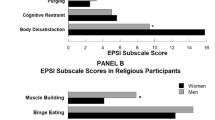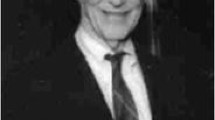Abstract
On average, our participants (N = 112), who self-proclaimed to be Christians, believed that physically inactive lifestyles, unhealthy eating, overeating, and being obese destroy the body, God’s temple. However, these beliefs were less definitive, than those of other common “sin” behaviors, such as drug use, smoking, and excessive drinking of alcohol. In addition, destroying the body with physical inactivity or poor diet was not necessarily viewed as sinful. Subsequently, these beliefs did not relate to self-reported physical activity, dietary behavior, or body mass index. It is possible that inactivity, poor dietary habits, and obesity are not internalized into the spiritual perspective as destroying the body, God’s temple, in the same way as other “sin” behaviors.
Similar content being viewed by others
References
Ajzen, I. (1991). The theory of planned behavior. Organizational Behavior and Human Decision Processes,50(2), 179–211.
Campbell, M. K., Hudson, M. A., Resnicow, K., Blakeney, N., Paxton, A., & Baskin, M. (2007). Church-based health promotion interventions: Evidence and lessons learned. Annual Reviews in Public Health,28, 213–234.
Cline, K. M. V., & Ferraro, K. F. (2006). Does religion increase the prevalence and incidence of obesity in adulthood? Journal for the Scientific Study of Religion,45(2), 269–281.
Cornwall, M. (1989). The determinants of religious behavior: A theoretical model and empirical test. Social Forces,68(2), 572–592.
Craig, C. L., Marshall, A. L., Sjostrom, M., Bauman, A. E., Booth, M. L., Ainsworth, B. E., et al. (2003). International physical activity questionnaire: 12-country reliability and validity. Medicine and Science in Sports and Exercise,35(8), 1381–1395.
Dodor, B. A. (2013). Effects of religiosity on physical activity, fast food intake, and obesity in emerging adults. Journal of Behavioral Health,2(1), 19–26.
Ford, E. S., Bergmann, M. M., Kroger, J., Schienkiewitz, A., Weikert, C., & Boeing, H. (2009). Healthy living is the best revenge: Findings from the European Prospective Investigation Into Cancer and Nutrition-Potsdam study. Archives of Internal Medicine,169(15), 1355–1362.
Friese, M., & Wänke, M. (2014). Personal prayer buffers self-control depletion. Journal of Experimental Social Psychology,51, 56–59.
Gillum, R. F. (2006). Frequency of attendance at religious services, overweight, and obesity in American women and men: The third national health and nutrition examination survey. Annals of Epidemiology,16(9), 655–660.
Hall, T. D., & Edwards, K. J. (1996). The initial development and factor analysis of the spiritual assessment inventory. Journal of Psychology and Theology,24(3), 233–246.
Healthy People 2020. Nutrition, physical activity, and obesity. Retrieved from http://www.healthypeople.gov/2020/leading-health-indicators/2020-lhi-topics/Nutrition-Physical-Activity-and-Obesity/data.
Holt, C. L., Lewellyn, L. A., & Rathweg, M. J. (2005). Exploring religion-health mediators among African American parishioners. Journal of Health Psychology,10(4), 511–527.
Holt, C. L., & McClure, S. M. (2006). Perceptions of the religion-health connection among African American church members. Qualitative Health Research,16(2), 268–281.
Holt, C. L., Schulz, E., & Wynn, T. A. (2009). Perceptions of the religion—health connection among African Americans in the southeastern United States: Sex, age, and urban/rural differences. Health Education and Behavior,36(1), 62–80.
Katz, D. L. (2009). Life and death, knowledge and power: Why knowing what matters Is not what’s the matter. Archives of Internal Medicine,169(15), 1362–1363.
Kegler, M. C., Escoffery, C., Alcantara, I. C., Hinman, J., Addison, A., & Glanz, K. (2012). Perceptions of social and environmental support for healthy eating and physical activity in rural southern churches. Journal of Religion and Health,51(3), 799–811.
Koenig, H. G. (2015). Religion, spirituality, and health: A review and update. Advances in Mind-Body Medicine,29(3), 19–26.
Koenig, H., King, D., & Carson, V. B. (2012). Handbook of religion and health (2nd ed.). New York, NY: Oxford University Press.
Kwok, C. S., Umar, S., Myint, P. K., Mamas, M. A., & Loke, Y. K. (2014). Vegetarian diet, Seventh Day Adventists and risk of cardiovascular mortality: A systematic review and meta-analysis. International Journal of Cardiology,176(3), 680–686.
Linardakis, M., Papadaki, A., Smpokos, E., Sarri, K., Vozikaki, M., & Philalithis, A. (2015). Are religiosity and prayer use related with multiple behavioural risk factors for chronic diseases in European adults aged 50+ years? Public Health,129(5), 436–443.
Lindholm, G., Johnston, J., Dong, F., Moore, K., & Ablah, E. (2016). Clergy wellness: An assessment of perceived barriers to achieving healthier lifestyles. Journal of Religion and Health,55(1), 97–109.
Lucchetti, G., & Lucchetti, A. L. G. (2014). Spirituality, religion, and health: Over the last 15 years of field research (1999–2013). The International Journal of Psychiatry in Medicine,48(3), 199–215.
Mahoney, A., Carels, R. A., Pargament, K. I., Wachholtz, A., Leeper, L. E., Kaplar, M., et al. (2005). The sanctification of the body and behavioral health patterns of college students. The International Journal of the Psychology of Religion,15(3), 221–238.
McCullough, M. E., & Willoughby, B. L. (2009). Religion, self-regulation, and self-control: Associations, explanations, and implications. Psychological Bulletin,135(1), 69–93.
McGinnis, J. M., & Foege, W. H. (1993). Actual causes of death in the United States. Journal of the American Medical Association,270(18), 2207–2212.
Mokdad, A. H., Marks, J. S., Stroup, D. F., & Gerberding, J. L. (2004). Actual causes of death in the United States, 2000. Journal of the American Medical Association,291(10), 1238–1245.
Moore, L. V., & Thompson, F. E. (2015). Adults meeting fruit and vegetable intake recommendations: United States, 2013. Morbidity and Mortality Weekly Report,64(26), 709–713.
Orlich, M. J., & Fraser, G. E. (2014). Vegetarian diets in the Adventist Health Study 2: A review of initial published findings. The American Journal of Clinical Nutrition,100(Supplement 1), 353S–358S.
Paxton, A. E., Strycker, L. A., Toobert, D. J., Ammerman, A. S., & Glasgow, R. E. (2011). Starting the conversation: performance of a brief dietary assessment and intervention tool for health professionals. American Journal of Preventive Medicine,40(1), 67–71.
Proeschold-Bell, R. J., & LeGrand, S. H. (2010). High rates of obesity and chronic disease among United Methodist clergy. Obesity,18(9), 1867–1870.
Reeves, R. R., Adams, C. E., Dubbert, P. M., Hickson, D. A., & Wyatt, S. B. (2012). Are religiosity and spirituality associated with obesity among African Americans in the Southeastern United States (the Jackson Heart Study)? Journal of Religion and Health,51(1), 32–48.
Reeves, M. J., & Rafferty, A. P. (2005). Healthy lifestyle characteristics among adults in the United States, 2000. Archives of Internal Medicine,165(8), 854–857.
Roozen, D. A. (2010). 2010 national survey of congregations. Retrieved from http://faithcommunitiestoday.org/sites/faithcommunitiestoday.org/files/2010FrequenciesV1.pdf.
Ruiz, A. L., & Acevedo, G. A. (2014). True believers? Religion, physiology, and perceived body weight in Texas. Journal of Religion and Health,54(4), 1221–1237.
Tonstad, S., Stewart, K., Oda, K., Batech, M., Herring, R. P., & Fraser, G. E. (2013). Vegetarian diets and incidence of diabetes in the Adventist Health Study-2. Nutrition, Metabolism and Cardiovascular Diseases,23(4), 292–299.
World Health Organization (2015). Noncommunicable diseases: Fact sheet. Retrieved from http://www.who.int/mediacentre/factsheets/fs355/en/.
Yeary, K. H. H., Jo, C., Simpson, P., Gossett, J. M., Johnson, G. S., McCabe-Sellers, B. J., et al. (2009). Religion and body weight in an underserved population. Race, Gender & Class,16(3/4), 82–98.
Yeary, K. H. C. K., Klos, L. A., & Linnan, L. (2012). The examination of process evaluation use in church-based health interventions a systematic review. Health Promotion Practice,13(4), 524–534.
Yoon, P. W., Bastian, B., Anderson, R. N., Collins, J. L., & Jaffe, H. W. (2014). Potentially preventable deaths from the five leading causes of death—United States, 2008–2010. Morbidity and Mortality Weekly Report,63(17), 369–374.
Author information
Authors and Affiliations
Corresponding author
Ethics declarations
Conflict of interest
The authors declare that they have no conflict of interest.
Rights and permissions
About this article
Cite this article
Faries, M.D., McClendon, M. & Jones, E.J. Destroying God’s Temple? Physical Inactivity, Poor Diet, Obesity, and Other “Sin” Behaviors. J Relig Health 59, 522–534 (2020). https://doi.org/10.1007/s10943-017-0368-2
Published:
Issue Date:
DOI: https://doi.org/10.1007/s10943-017-0368-2




